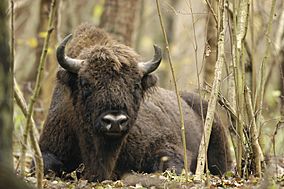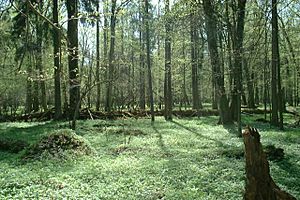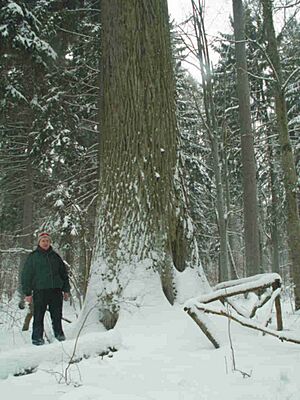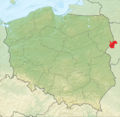Białowieża Forest facts for kids
Quick facts for kids Białowieża Forest |
|
|---|---|
|
IUCN Category II (National Park)
|
|

Wisent in natural habitat
|
|
| Location | Hrodna and Brest administrative districts of Belarus, Podlaskie Voivodeship in Poland |
| Area | 152.2 km² [1] |
| Established | 1932 |
| Governing body | Ministry of the Environment of Belarus and Poland |
The Białowieża Forest is a very old and special forest. It sits right on the border between Poland and Belarus. This amazing forest is one of the last and largest parts of a huge ancient forest that once covered much of Europe.
It's so important that it's a UNESCO World Heritage Site and a Biosphere Reserve. This means it's protected by international groups because of its unique nature. The forest is home to about 800 wisent, which are the heaviest land animals in Europe! A special border crossing lets hikers and cyclists explore parts of the forest on both sides.
Contents
Exploring the Forest
The Białowieża Forest is split into two main parts, one in Belarus and one in Poland. Both sides work to protect this incredible natural area.
Belarusian Side
On the Belarusian side, the protected area is very large, covering about 1,771 km2 (684 sq mi). The main office for the Belavezhskaya Pushcha (the Belarusian name for the forest) is in Kamieniuki. It has a laboratory and a zoo where you can see animals like wisent, konik (a type of wild horse), wild boar, and moose. There's also a small museum to learn more about the forest.
Polish Side
In Poland, a part of the Białowieża Forest is protected as the Białowieża National Park. This park covers about 100 km2 (39 sq mi). There's a special area called the Białowieża Glade, which has buildings that once belonged to the Russian tsars. The tsars were like kings who owned the forest a long time ago.
Today, you can find a hotel, restaurant, and parking areas here. You can take guided tours into the most protected parts of the park, either by walking or in a horse-drawn carriage. Many people visit the Polish side each year to enjoy activities like bird watching, seeing wisent in their natural home, and even going on sledge rides in winter. The popular village of Białowieża is also located within the forest.
Famous Old Oaks
The Białowieża Forest is famous for its many huge, ancient pedunculate oaks. Some of these trees are so old and special that they have their own names! Their size is measured around the trunk at about chest height.
- Great Mamamuszi: This is one of the thickest oaks in the forest, with a trunk that looks like a tall column. It's still growing and is in very good health.
- The King of Nieznanowo: This oak has a very straight trunk. It started dying in 1998, and by 2005, only a few small branches still had leaves.
- Barrel Oak: This tree is named because its trunk looks like a giant barrel. It has the largest trunk size of all the Białowieża oaks. This tree is now dead and is about 450 years old.
- Dominator Oak: This was once one of the thickest oaks in the forest. It died in 1992 and is also around 450 years old.
- The Jagiełło Oak: This is probably the most famous tree in the forest, even though it fell down in 1974. People say that King Władysław II Jagiełło rested under it before a big battle in 1410. However, the tree was likely only about 450 years old when it fell.
- Tsar Oak (Polish): This huge oak is about 41 m (135 ft) tall. It died in 1984 and has been standing dead for over 20 years.
- Tsar Oak (Belarusian): This is the oldest oak in Belarus, standing 46 m (151 ft) tall and being over 800 years old! It has been a national monument since 1963.
Protecting the Forest
Some people are worried about logging (cutting down trees) in the Białowieża Forest. Environmental groups say that logging could harm the plants and animals, especially rare birds. However, Poland's state forestry board says that they only cut trees for protection and to help the forest stay healthy. It's a complex issue about how to best care for such an important natural place.
Images for kids
-
Bison in Białowieża Forest
See also
 In Spanish: Bosque de Białowieża para niños
In Spanish: Bosque de Białowieża para niños













